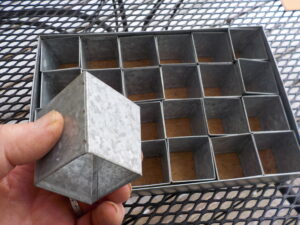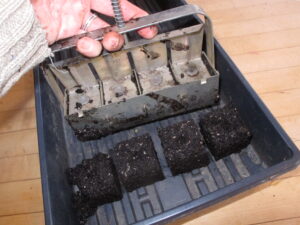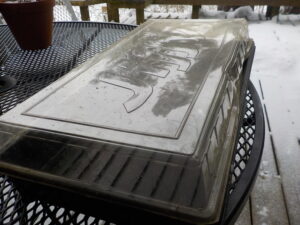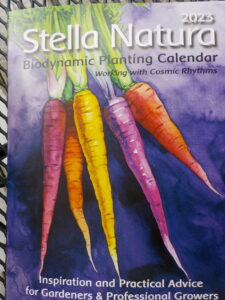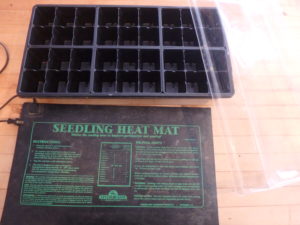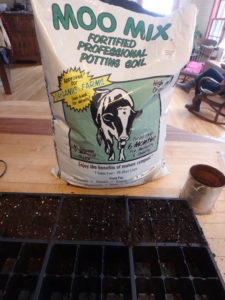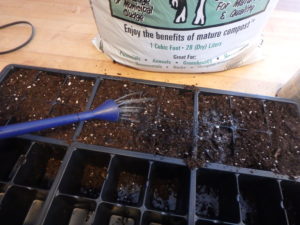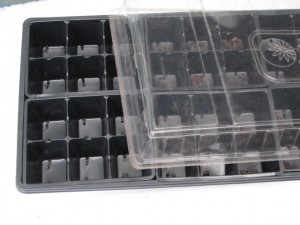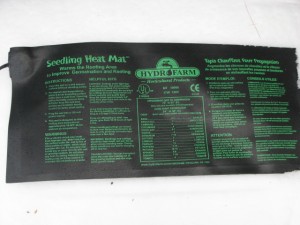Get Ready to Start Seedlings Indoors
Gardeners Supply Company has been offering ways of reducing single-use plastics like those 6-packs sold everywhere. They have sturdy reusable plastic trays for seed starting which have been available for a few years. This year they came out with metal seed starting trays.
If you don’t mind extra work and lots of mess, you can make soil blocks using a little metal press that produces 2-inch soil blocks. The mixture includes peat humus, compost, soil, blood meal and minerals. E-mail me for more info about the process.
Most seeds will wake up and grow more readily if you place them on a warm base. Electrical seed-starting mats are great for that, but not really necessary. I use them for things that specify warmer temperatures, like the flower Lisianthus, and for hot peppers.
You can contain moisture by buying and using clear plastic covers for your flats of seedlings. They are inexpensive and reusable. Take them off after everything has germinated, or most things.
Starting Seedlings Indoors: How, When, Where?
Is it time to start seedlings yet? Yes, for a few things: artichokes, broccoli, Brussels sprouts, cabbage, onions and leeks, kale and peppers. Tomatoes I start in early- to mid-April, along with eggplants, lettuce, melons and squashes of all sorts. Root crops are generally started outdoors later on, but I have started beets indoors on occasion for an extra early crop.
If you want a lot of annual flowers, starting by seed can be a big saving. But, as with vegetables, you have to do it just right in order to get plants that resemble the ones you would buy at the garden center.
If I just want a 6-pack of nasturtiums, it is cheaper to buy them as plants than as seeds. A packet of seeds often costs $5 or so, though the FEDCO cooperative sell little packets for just $1.30. Those packets generally contain a gram of seeds, and the on-line catalog tells you how many seeds are in it- usually plenty (or more than enough) for a one-year supply.
Most seeds are good for 3 years. But onions, sweet corn, parsnips and spinach are only good for one year. Peas, beets and Swiss chard are good for one or two years. Flowers vary – experience will tell you, or the seed package will. If you have older seed, plant more seeds – not all will germinate, but some probably will.
To get good looking plants, you need lights. Yes, there are people who start plants on windowsills, but those plants quickly get tall and leggy as they reach for light. If you want to start some lettuce seedlings in late April on a window sill, sure, you can keep them there for a month before putting them outside. But tomatoes? Forget about it.
Buy 4-foot fluorescent lights and hang them 6 inches above your seed flats. As the plants grow, move the lights up to keep them at the right distance. Now there are LED lights made for the same 4-foot fixtures you may already have, and they are supposed to be more effective and less expensive to run. They are available on-line from Gardeners Supply Company. LED lights should last for 20-plus years. I use something called jack chain, which I get at the hardware store, to hang my lights as it is easy to adjust the length of the chain.
I use a biodynamic calendar called Stella Natura (www.stellanatura.com) to guide me when to plant seeds. It uses the sun, moon and stars to determine when optimal dates are for planting. It also gives “black-out” days to avoid. I’ve tested the black-out days, and never plant on them. Sunday, April 8 will be good for starting tomatoes this year, but the 11th to 13th will be black-out days.
Seeds have a built-in heat-sensitive trigger that controls germination. It would be a bad idea for a seed to germinate in January, for example, even if there were no snow. Cold would kill the seedlings. Warm soil tells a seed that the sun is strong, has been for some weeks, and probably will continue to be strong and warm.
You can add bottom heat to your seed flats by buying electric heat mats. They are about the size of a flat, and add a low, gentle heat to warm the starting mix your seeds are planted in. They will speed up germination considerably.
Don’t even think of starting seeds in garden soil. Although I sometimes make soil blocks from compost and peat moss with some added garden soil, usually I just buy Moo-Doo brand planting mix that I put in little plastic 6-packs. I always buy the 6-packs that have the biggest cells available. Some come with 72 compartments to the flat, some 48 and others 36 or 32. I like the 32’s – they have more room for roots.
Seeds are very sensitive to drying out, especially just after they have germinated. To minimize the chances of that, I use plastic covers that fit on the flats. These are clear, allowing light to pass through, but not moisture. Safely stored, these are good for many years. You can save and wash the 6-packs but they are cheaply made and often crack or break, so I don’t bother most times.
Read the seed packets when planting seeds. Lettuce seeds need light to germinate, so just a very fine layer of planting mix or fine vermiculite will do. A big seed like a squash needs half an inch or more of cover. Generally the bigger the seed, the deeper the hole. I use a pencil to make a divot for each seed.
Because the Queen of the Garden is the tomato, I plant 2 seeds in each cell. Usually both germinate. The hard part is then snipping off one of the two. It feels awful to kill a tomato, but growing both in a small cell will result in stunted growth and completion for nutrients. And if the seedlings get too big, I transplant some into small pots.
As plants grow, they quickly use up the minerals that came in the potting mix. I make a dilute solution of fish and seaweed fertilizer and use it to water my seedlings. That’s what nurseries do, although most use chemical fertilizers – sometimes pushing the plants to grow too fast. And since I am not going to use chemical fertilizers, I don’t want plants that expect them.
Starting seedlings is a sure cure for MSB (Mud Season Blues). I love watering and admiring my little tomatoes, and dreaming of them in sandwiches on thick slices of all-grain bread with rich mayonnaise. Sigh. That’s still a long way off.
You may reach Henry by e-mail at henry.homeyer@comcast.net. His website is www.Gardening-Guy.com.
Starting Seedlings Indoors
Before we launch into this week’s article…
Gardening Classes with Henry
Lebanon College: Gardening: A Practical Workshop. Garden writer Henry Homeyer will teach you the basics of organic vegetable and flower gardening. From garden design to seed-starting , planting, watering, weeding, mulching, and harvesting, this course will give each student practical knowledge of gardening. Tuesday nights from 6:30-8:30 for 5 weeks, April 3-May 2.Contact Lebanon College to reserve a spot for this5-part workshop www.lebanoncollege.edu or call 603-448-2445.
AVA Gallery, Lebanon. Henry will teach 3 classes at AVA Gallery this spring. You may sign up for one or all of these workshops:
Sculpting the Living Landscape: Starting Flowers from Seed
April 9; Monday, 6:30–8:30pm; One 2-hour class
Sculpting the Living Landscape: Perfect Perennials for the Upper Valley Garden
April 23; Monday, 6:30–8:30pm; One 2-hour class
Sculpting the Living Landscape: Organic Techniques for Enriching Soil and Managing Pests
May 7; Monday, 6:30–8:30pm; One 2-hour class
For more information go to www.avagallery.org or call 603-448-3117.
Starting Seedlings Indoors
As winter morphs into spring, I get antsy. I want to start growing things. Even though it is still too early for starting most things by seed, it is the right time to plant artichokes, onions, peppers and leeks indoors. Tomatoes? Not until April. Squash? Not until May.
Whatever and whenever you start, there are several variables that need to be controlled: light level, moisture, available fertilizer and temperature. Pay attention to these factors and you will do well. The first thing I do each year is get out my lights. Starting seedlings on windowsills really doesn’t work for most things. Little seedlings get tall and leggy, reaching for light if all they get is a few hours of sunshine in a window.
My lights were an investment, but have paid for themselves many times over the years. I start 200-300 seedlings each year and seeds are much cheaper than seedlings bought in 6-packs at the nursery. And I often start 20 kinds of tomatoes and half a dozen types of hot peppers – most of which I would never find for sale.
This year I have upgraded my lights. The old T-12 (fat style) fluorescent tubes lose their potency over time, and are less efficient than the modern, thinner T-8 tubes. And the T-12 lights are being phased out due to federal energy regulations. So if you have old lights, think about upgrading. LED lights are also available, and while considerably more expensive than fluorescents, they are more energy efficient. I got some from Sunshine Systems (www.sunshine-systems.com or 866-576-5868).
If you don’t want to invest in a plant stand, a card table will do if you’re not starting too many plants. Still, I like my stand because it will hold 2 flats of plants on each shelf, and has 3 shelves – that’s enough for about 200 seedlings. Gardener’s Supply (www.gardeners.com or 888-833-1412) has some nice plant stands, but they are not cheap. Try your local garden center, too, or think about making your own. If buying, look for a stand that allows you to raise the lights as plants grow – 6 inches above the plants is ideal. One last thing: only run your lights 14 hours a day. They need their beauty rest, too.
When seeds first germinate they are very sensitive to drying out, so I like the clear plastic covers that are sold to fit over flats. They hold the moisture like little greenhouses. If you use them, plant things that germinate at the same rate in any given flat – germination times can vary from 3 to 18 days, depending on the plant species. Remove the covers as soon as plants touch them.
Don’t keep your seedlings soggy. Let the potting mix dry out before watering. You may need to water lightly every day as plants get bigger, however.
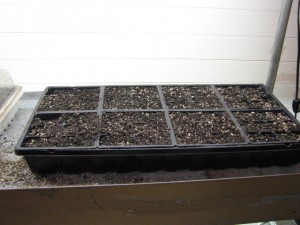 If you buy potting soil or seed starting mix, it is mostly peat moss, which has little nutrition to offer a plant. It is used for its ability to hold moisture. I suggest mixing it 50-50 with compost – either your own homemade stuff or the kind that comes in a bag.
If you buy potting soil or seed starting mix, it is mostly peat moss, which has little nutrition to offer a plant. It is used for its ability to hold moisture. I suggest mixing it 50-50 with compost – either your own homemade stuff or the kind that comes in a bag.
Even with compost added to the mix, as your plants get bigger, you will need to offer some plant food. I don’t recommend using the chemical versions. My plants, once in the garden, will have to grow without chemical fertilizer, so I don’t want to give them any now. I believe that my seedling’s root systems will be more vigorous if they are not given lots of soluble chemical fertilizer.
The options for natural fertilizers are many. You can buy fish or seaweed fertilizers such as Neptune’s Harvest. Some fish fertilizers (made as emulsions) have an odor that may offend the nostrils of sensitive people. Neptune’s Harvest claims theirs is not stinky due to their special hydrolyzing process. Mega Green is another brand of fish fertilizer made by hydrolysis; it combats odor with natural mint essences, too.
Temperature is a key factor, too. I have electric heat mats that I place under my flats – bottom heat helps germination. These mats are sold at garden centers and may seem expensive, but if you grow peppers, for example, they really help. Once seedlings are up and growing I remove the mats– too much heat will push growth too fast (though sometimes I keep my peppers on them longer – they love heat).
I like 65-70 degrees during the day and 10 degrees cooler at night. A spare bedroom is a good place to grow things – you may be able to regulate the temperature by opening a window or turning off the radiator.
Finally, I like to move tomato and pepper seedlings into 2 or 3 inch pots once they are 4-6 weeks along. This allows the plants to have bigger root systems and minimizes root crowding. Our seasons can be cut short by fall frosts, so I like to give my plants any advantage I can.
You may reach Henry Homeyer at henry.homeyer@comcast.net



